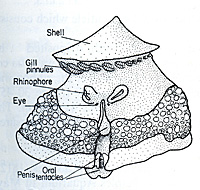|
< Previous family introduction |
|
|||||
 |
Families Umbraculidae and Tylodinidae
|
|||||
|
The Umbraculoidea consists of only two families, Tylodinidae and Umbraculidae. In both, the animals are large, surmounted by a smaller limpet-like shell that covers only the visceral mass and gill. There is a plume-like external gill on the right side between the mantle and foot. In the Tylodinidae the animal is elongate, with prominent tentacles and rhinophores, it has a smooth surface, and is yellow in colour. In the Umbraculidae the animal is globular and ponderous, with the surface covered by large pustules. The tentacles, rhinophores and mouth are hidden in a cleft at the front of the foot where there is a permanently everted penis. Animals in both families feed on sponges; for Tylodinidae these are of the family Aplysinellidae, while Umbraculidae feeds on a diverse range. Umbraculum does not have an extensible pharanyx, so to feed it needs to press its mouth directly onto the food sponge. In Tylodinidae the principal genus Tylodina includes only 5 species worldwide, of which only one occurs in Australia. In the Umbraculidae there is only one species, Umbraculum umbraculum, which supposedly has a world-wide distribution in warm and temperate seas. Numerous other names have been introduced, but prevailing opinion is that there is only one species. Family References: Thompson, T.E. 1970. Eastern Australian Pleurobranchomorpha (Gastropoda: Opisthobranchia). Journal of Zoology, London. 160: 173-198. Willan, R.C. 1984. A review of the diets in the Notaspidea (Mollusca: Opisthobranchia). Journal of the Malacological Society of Australia 6(3&4): 125-142. Coverage The only two species known from NSW are treated here. Identification Notes Shells in these families are limpet-shaped, light to medium in weight, usually with concentric growth lines, and vary from almost flat to moderately elevated. They are often covered with marine growth, and eroded.
|